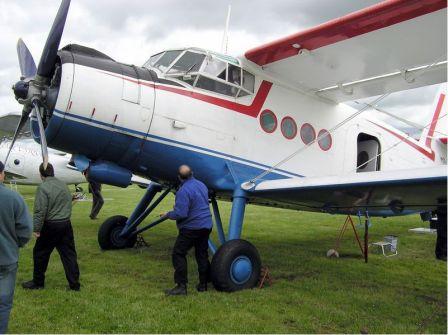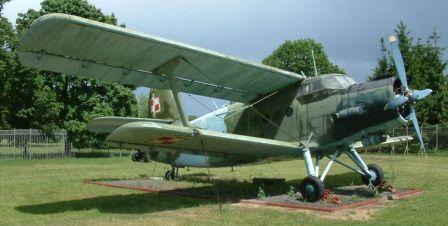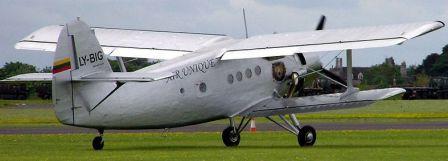Antonov An-2
Antonov An-2 (NATO codename "Colt"). A perfect bush plane waiting to happen.
Now here's a weird one that few people who survived the Cold War would ever expect to see over Western skies. This is at least, in times of peace. The An-2 is a monstrosity, it is the largest single engine bi-plane ever built. And built it was, Russia produced 5,000 examples, Poland produced 12,000 and China, well no one really knows how many China produced but presumably oodles of An-2s noodle over the skies of China. An-2s are still being produced in occasional odd lots.

Not exactly like any plane ever made in the west. When the An-2 first became known to western observers, most of them laughed hysterically and considered the An-2 as proof positive that the Russians were a backward bunch of simpletons. Even knowledgeable observers who knew Russia wasn't planning to ever use this plane to fight hand-in-hand with its MiGs to defeat the debauched capitalists, still considered it to be a wee bit rudimentary. After all, the fuselage section was that of a C-47 (DC-3, from the licensed built Li-2) only cut down in length by approximately one-half.
The engine is a Russian development of the Wright R-1820 Cyclone 9. The AN-2 engines have been approved for installation on deHavilland Otters, which originally featured the Pratt & Whitney Wasp engine that produced 600 hp.
Also, AN-2s can be bought and sold in the west relatively cheaply. It is not unheard of for these huge biplanes to sell, in flying condition, for $30,000. Few if any, ever envisioned the Cold War would end in this manner.

As mentioned earlier, the Russians never intended this plane to fly alongside its MiG-15, and 17 to attack the imperialists, instead, it was designed as a Russian equivalent to a bush plane. In that respect, Russia had a winner and the plane was a natural design for the Russian country. To understand this, let's consider Russia, then and now, and it will be easy to see why the An-2 was such a winner. Russia covers 11 time zones which by all rights makes it a big country. Much of this land is covered with birch and pine trees (like Alaska and Canada) and few roads or airports exist in these vast areas. Southern Russia ranges from vast steppes to outright deserts and, once again, there is a distinct lack of infrastructure.
The An-2, which has outstanding STOL capabilities, is perfect for these varied, but inhospitable lands. The An-2 is happy to fly along at 35 mph and because the top wing is fitted with slats, an An-2 really won't stall. Like the Helio, it will just start to sink if it is flown too slowly, but it won't truly stall. On the negative side, the An-2 is no speedster, 100-120 mph is a typical cruise speed and if a pilot gives it full throttle and aims it straight down, he or she might see the airspeed indicator crowd up to 145 mph.
With all of this in mind, one might naturally wonder why the An-2 is not more common in the bush. Because the An-2 was never licensed under any relevant airworthiness authorities, there are pretty severe restrictions on its use in the west. It cannot be used for profit, it cannot fly more than 300 miles away from its home base and it can't land anywhere other than its home base. Planes built in Poland are arguably exempt from these restrictions (because of reciprocal licensing agreements) but still, the An-2 is not common in the west.

Even aside from the restrictions, the An-2 is a big, fuel hungry bird. It burns approximately 50 gph in cruise, gulps oil by the gallon all while plodding through the sky at 100 mph. In other words, the An-2 is a little much for a private owner that cannot pack it full of revenue paying passengers or cargo. The An-2 is also an old plane, with old systems. What this means in practical terms is the An-2 is not a "get in it and go" airplane, it easily takes a half hour just to preflight an An-2. All of this becomes a bit much for a pilot that wants to enjoy relatively limited flights around the home base.
Watch as this pilot takes us through the AN-2 Antonov Radial Engine Start procedure.
Maintenance is also questionable on these old Russian birds, despite assurances from internet sellers that maintenance is "absolutely no problem." One has to wonder what a mechanic's eyes would do if you rolled up in an An-2 and said, "Hey, how about annualing my bird?" Sheer terror and/or dollar signs would likely be reflected in the mechanic's eyes and neither bodes too well for the aircraft owner.
There's also many seeming trifling things about An-2s which become really big deals when one attempts to own one of them. Want to know what the pilot's manual says about such-and-such? You better be pretty good at the Cyrillic alphabet and reading Russian (or Chinese, or Polish) because that's likely what your books will be in on this plane—that is if you even get any books with it. Want to convince the local authorities that the Cold War is over and it really is okay to toot around the sky in a russkie airplane? Well good luck, some people will never take a liking to the An-2 despite its obvious redeeming qualities.
In short, the An-2 is a great airplane that is perfect for the bush but will probably never be seen in great numbers. If you're loaded with bucks, don't have anywhere particular to go and just absolutely have to take 12 or so of your best friends with you, then the An-2 might be perfect for you. Otherwise, you are advised to steer clear of the otherwise sweet, big Russian bird.
Watch as a team of British, German and American paratroopers try the Soviet style low altitude air assault jump from an Antonov AN-2 aircraft. Jump altitude is from 100 meters (300 feet). Parachute is the Soviet D1-5-U with Z-5 reserve. This video is dated February 1998 and takes place in Volosovo, Russia.
Watch this AN-2 in an extreme Siberian take-off.
The AN-2 makes a landing in some serious wind conditions.
What is the Best Bush Plane?
Do you have a great story, an opinion, a tip or a review about this plane? Share it!